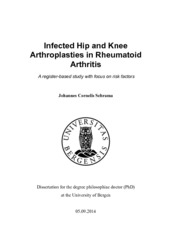| dc.contributor.author | Schrama, Johannes Cornelis | en_US |
| dc.date.accessioned | 2014-09-23T13:16:30Z | |
| dc.date.available | 2014-09-23T13:16:30Z | |
| dc.date.issued | 2014-09-05 | eng |
| dc.identifier.isbn | 978-82-308-2894-6 | en_US |
| dc.identifier.uri | https://hdl.handle.net/1956/8529 | |
| dc.description.abstract | Rheumatoid arthritis (RA) is a chronic autoimmune inflammatory disease which primarily affects and damages synovial joints. Patients with RA will therefore often undergo joint replacement surgery. Infections after such prosthetic joint replacements are rare but feared complications. RA patients are more susceptible to infections in general and the use of modern aggressive immunosuppressive treatment, such as TNF inhibition (from around the year 2000), may have increased this risk for infection. We have used data from the Norwegian Arthroplasty Register (NAR) from 1987 until 2008 (Paper I) and from the much larger database of the Nordic Arthroplasty Register Association (NARA) from 1995 to 2010 (Paper III) to compare the risk of revision for infection in and over time for RA and osteoarthritis (OA) patients. The risk of revision for infection was 1.6 times increased in total knee replacements (TKRs) for RA patients compared to OA patients (Paper I). In total hip replacements (THRs) we found a 1.3 times higher risk of revision for infection in RA compared to OA (Paper III). We concluded that there was a higher risk of revision for infection in RA than in OA patients. For TKRs there was no increase in the risk of revision for infection in RA or in OA patients after the year 2000. In the Norwegian study (Paper I) the incidence of revision for infection of THRs was higher in the period 2001-2008 than in the period 1987-2000. However the increase affected RA and OA patients to the same degree. In the Nordic study (Paper III) the relative risk for RA patients compared to OA patients was increased in the latter period (2002-2010). This coincides with the introduction of TNF inhibitors in the medical treatment of RA. Similarly conflicting results are also found in the literature. From 5-6 years postoperatively, the risk of revision for infection was increased in RA compared to OA in TKRs and THRs (Paper I). Furthermore, we found a higher risk during the first three months and from around 8 years postoperatively in antibiotic-loaded cemented prostheses in RA-patients (Paper III), while no significant difference in the risk of infection for revision was found when comparing RA and OA patients with uncemented THRs. We conclude that the increased risk for late infections in RA is primarily seen for prostheses fixed with antibiotic-loaded cement. Staphylococcus aureus (S. aureus) has been reported to be the most important causative bacteria in prosthetic joint infection (PJI) in RA. In addition, RA patients are by many authors considered to represent a high-risk group in terms of acquiring infections with bacteria of potentially oral or dental origin. In Paper II we compared the bacterial findings of infections leading to revision in THRs in RA patients with OA patients, based on data from the NAR. We identified 49 infection episodes in 37 RA patients and compared the bacterial findings with 269 infection cases in 255 OA patients. No difference in bacterial findings between RA and OA was found and thus we could not confirm the higher incidence of S. aureus in RA reported previously. Bacteria of potentially odontogenic origin were not found in RA patients but were found in 4% of OA patients and based on our study we could not confirm that RA patients are high-risk patients for infection with bacteria of oral or dental origin. | en_US |
| dc.language.iso | eng | eng |
| dc.publisher | The University of Bergen | eng |
| dc.relation.haspart | Paper I: Schrama, J. C., Espehaug, B., Hallan, G., Engesæter, L. B., Furnes, O., Havelin, L. I. and Fevang, B.-T. S. (2010), Risk of revision for infection in primary total hip and knee arthroplasty in patients with rheumatoid arthritis compared with osteoarthritis: A prospective, population-based study on 108,786 hip and knee joint arthroplasties from the Norwegian Arthroplasty Register. Arthritis Care Res, 62: 473–479. The article is not available in BORA due to publisher restrictions. The published version is available at: <a href="http://dx.doi.org/10.1002/acr.20036" target="blank">http://dx.doi.org/10.1002/acr.20036</a> | en_US |
| dc.relation.haspart | Paper II: Schrama, J. C., Lutro, O., Langvatn, H., Hallan, G., Espehaug, B., Sjursen, H., Engesaeter, L. B. and Fevang, B. T. (2012), Bacterial Findings in Infected Hip Joint Replacements in Patients with Rheumatoid Arthritis and Osteoarthritis: A Study of 318 Revisions for Infection Reported to the Norwegian Arthroplasty Register. ISRN Orthopedics, 2012: 437675. The article is available at: <a href="http://hdl.handle.net/1956/8528" target="blank">http://hdl.handle.net/1956/8528</a> | en_US |
| dc.relation.haspart | Paper III: Schrama, J. C., Fenstad, A. M., Dale, H., Havelin, L., Hallan, G., Overgaard, S., Pedersen, A. B., Kärrholm, J., Garellick, G., Pulkkinen, P., Eskelinen, A., Mäkelä, K., Engesæter, L. B. and Fevang, B. T. (2014), Increased risk of revision for infection in rheumatoid arthritis patients with total hip replacements. A study of 390,671 primary arthroplasties from the Nordic Arthroplasty Register Association. Acta Orthopaedica, 86(4): 491-497. The article is available at: <a href="http://hdl.handle.net/1956/11390" target="blank">http://hdl.handle.net/1956/11390</a>. | en_US |
| dc.title | Infected Hip and Knee Arthroplasties in Rheumatoid Arthritis. A register-based study with focus on risk factors | en_US |
| dc.type | Doctoral thesis | |
| dc.rights.holder | Copyright the author. All rights reserved | |
